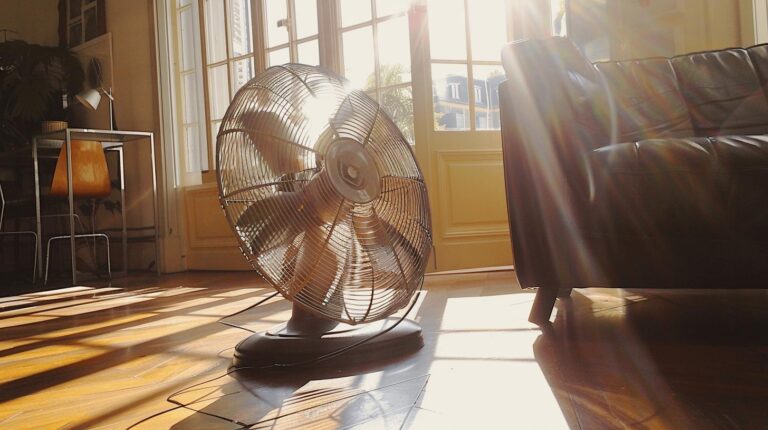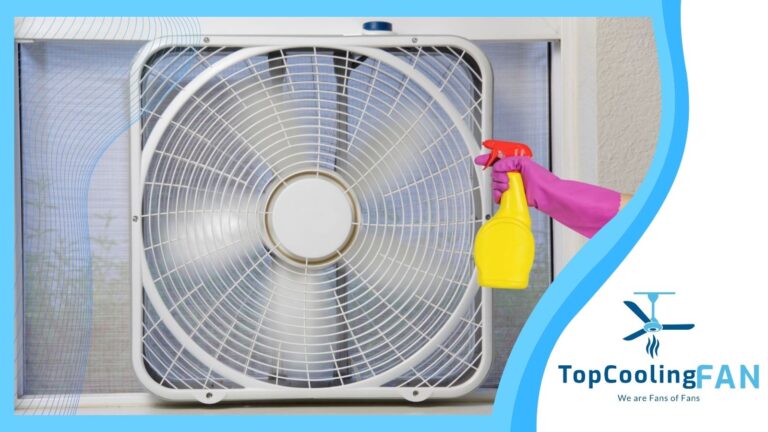Efficiency Check: Are Box Fans Energy Hogs?
When considering the cost of running household appliances, it’s important to look at their energy consumption. A box fan is often used for extended periods, especially during hot weather, prompting many to wonder about its impact on the electricity bill.
Box fans are a popular choice due to their portability and affordability. They also present a more energy-efficient option compared to larger cooling systems, such as air conditioners.
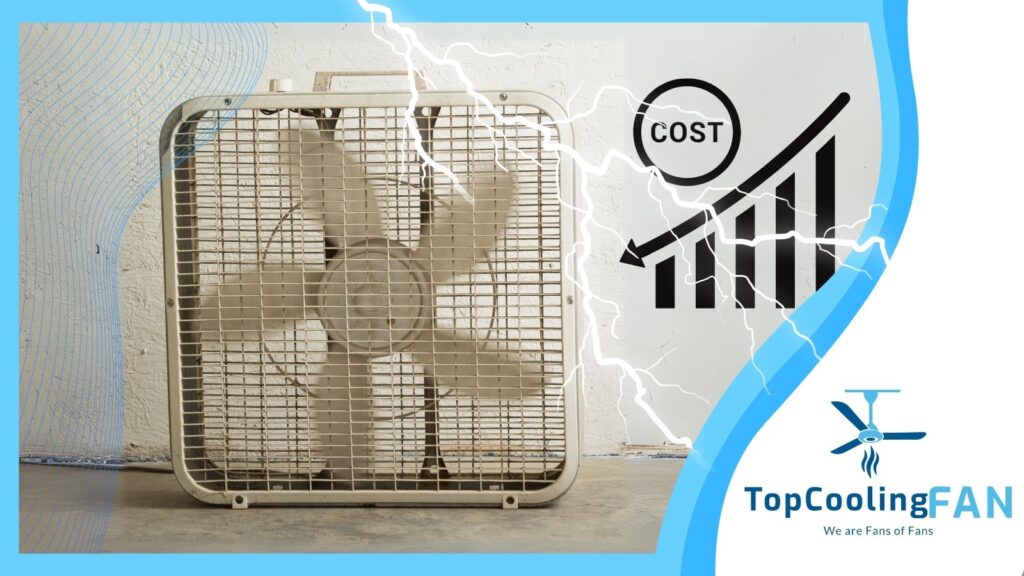
Most box fans consume between 20 to 100 watts per hour, which positions them on the lower end of the energy use spectrum. The energy used can vary depending on the size of the fan and the speed setting.
For instance, a typical 20-inch box fan will draw about 75 watts of electricity at full speed. Using the fan on a lower speed setting can reduce consumption by nearly half, saving energy and money.
Knowing the wattage of a box fan can aid in understanding how it translates to the electricity bill. Small changes, like opting for the lower setting or using the fan only when necessary, can make a significant difference.
They are not only effective in promoting air circulation but also do so without greatly increasing energy costs. These qualities make the box fan a practical and cost-effective solution for staying cool.
Understanding Box Fans

In this section, readers will learn about the basic design and utility of box fans, how they compare to other fan types, and the distinct features that affect their efficiency.
What Is a Box Fan?
A box fan is a portable fan consisting of a square or rectangular frame housing a set of blades that spin to move air. These fans range in size, typically from 10 to 20 inches, with the 20-inch box fan being a common household choice. They are versatile, often used for ventilation, cooling, or just circulating air.
Comparing Fan Types
Box fans are just one type of many fan designs. When compared to tower fans, they often take up more space but offer a larger airflow due to their size.
Ceiling fans are fixed and can provide airflow for an entire room, while window fans are designed to fit in a window frame.
Tower fans, meanwhile, offer a slimmer profile and often include additional features like oscillation. Air conditioners, although not fans, provide a cooling effect through refrigeration, but at a significantly higher energy use.
In terms of efficiency, box fans are a simple and energy-efficient option for personal cooling.
Box Fan Features
Key features of box fans include their blades, fan speed settings, and portability.
Typically, a box fan will have three speed settings that allow users to adjust the airflow. The design is straightforward, with a focus on maximizing airflow through the size and efficiency of the blades.
The fan’s size affects both its airflow potency and energy consumption.
Electricity Usage of Box Fans
Understanding the electricity usage of box fans is essential for consumers who are conscious about their energy consumption and want to manage their electricity bills effectively. This section breaks down the power usage into wattage and cost considerations, as well as the variables that impact the overall electricity use of these appliances.
Wattage and Power Consumption
Box fans are widely recognized for their energy efficiency. The wattage for these fans typically ranges between 50 to 100 watts.
For instance, an average 20-inch box fan uses approximately 75 watts when operating at maximum speed. Smaller box fans, like a 10-inch model, may use around 25 watts—the lower end of the spectrum.
Cost of Running a Box Fan
The cost to run a box fan hinges on the fan’s wattage and the local cost per kWh (kilowatt-hour).
To calculate the daily cost, multiply the fan’s power consumption in kW by the number of hours it’s used and by the electricity rate.
- Cost = (50 watts / 1000) x 8 hours x $0.12 per kWh
- Cost = $0.048 per day
Factors Affecting Electricity Use
Several factors influence a box fan’s electricity use.
The speed setting is significant; using a fan on the lowest setting can reduce its electricity usage significantly.
Other factors include the model of the fan, its efficiency, and the frequency of its use.
Users must also consider the broader variables such as electricity rates, which vary by location, and the current price for electricity.
Practical Tips for Box Fan Usage
To make the most of your box fan, whether you’re looking to save on your energy bill, stay comfortable, or simply maintain your fan for durability, the following tips can be extremely beneficial.
Optimizing Efficiency
- Choose Energy-Efficient Models: Selecting a box fan with low power consumption is fundamental. Energy-efficient box fans can significantly reduce energy costs without sacrificing comfort level.
- Adjust Settings Appropriately: Use the lowest setting that still provides ample cool air to maintain a comfortable temperature. This little adjustment can lead to energy savings over time.
Maintaining Your Box Fan
- Regular Cleaning: Dust and debris can decrease a fan’s efficiency. One should clean the blades and vents regularly for the fan to function at optimal performance.
- Inspect Cords and Motors: Ensuring that the cords are not frayed and the motor is functioning properly can extend the lifespan and maintain the efficiency of your box fan.
Proper Placement for Maximum Comfort
- Strategic Positioning: Place your box fan in a location where it can move air most effectively throughout the room. It should facilitate the flow of warm air out and cool air in.
- Avoid Obstructions: Any obstruction that blocks the intake or output of the fan can hinder its performance. Always give it ample space for air circulation for the best comfort level.
Box Fan Usability and Features
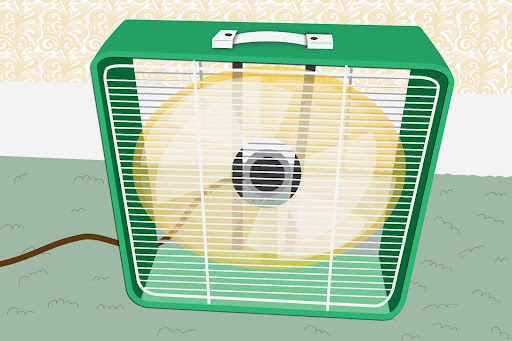
Box fans are a popular and versatile option for cooling spaces efficiently. They offer a variety of speed settings and are designed for easy portability, with some models featuring low noise levels for a more comfortable environment.
Speed Settings and Air Flow
Box fans typically offer multiple speed settings, allowing users to adjust the air flow to their comfort level.
The CFM (cubic feet per minute), which measures the volume of air a fan can move, varies across different models and settings.
For instance, at full speed, a standard 20-inch box fan can provide a CFM rating that effectively circulates air in medium-sized rooms.
Design and Portability
Designed with convenience in mind, box fans are known for their portability. They are often lightweight, with a handle for easy transportation. This feature makes them an ideal choice for users who need to move their cooling solutions from one room to another or even for outdoor use, like on a patio.
Noise Levels
The noise generated by a box fan can vary.
While most models operate relatively quietly, the sound can increase with the fan’s speed. Manufacturers take this into account and strive to reduce noise while maintaining effective air movement.
Users should consider the noise level relative to the fan’s location and the activities in the surrounding area, aiming for a balance between cooling power and a tranquil environment.
Environmental Impact
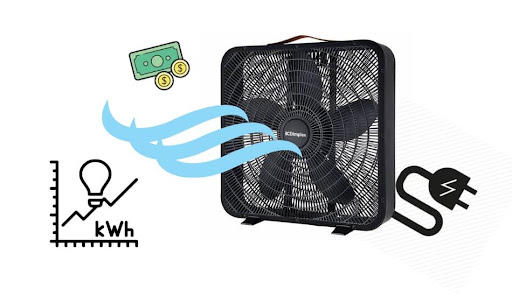
When considering the environmental impact of cooling appliances, box fans are often highlighted for their lower electricity consumption compared to air conditioning units. This can directly translate to a reduced carbon footprint.
Reducing Carbon Footprint with Box Fans
Box fans are a more energy-efficient option for cooling, as their energy use is generally lower than that of air conditioners.
This implies that they can contribute to a lower carbon footprint when they displace the use of more energy-intensive cooling units.
According to a study by Citizen Sustainable, the material production and energy consumption during the use phase of fans can impact the environment.
However, by choosing models with Energy Star certification, consumers can ensure they are selecting box fans that meet strict energy efficiency guidelines established by the EPA. This, in turn, contributes to less fossil fuel combustion and reduced greenhouse gas emissions.
Moreover, making informed decisions about electricity usage with devices such as box fans can further enhance their environmental benefits.
For instance, a typical 20-inch box fan uses about 86.5W at full speed, and less at lower speeds, which is substantially less than many air conditioning systems.
Notably, some models can consume as low as 53W, increasing their energy efficiency and thereby decreasing their environmental impact.
Cost Comparison with Other Cooling Methods
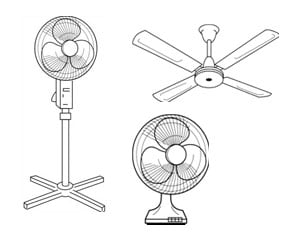
When considering the cost of cooling one’s home, it’s important to evaluate how different methods stack up against each other regarding electricity consumption.
Box Fans vs. Air Conditioners
Box fans are significantly more energy-efficient than air conditioners. On average, a standard box fan uses between 40 to 100 watts of power, depending on the size and setting. In contrast, a central air conditioning system can consume around 3,500 watts when operating.
For a more tangible comparison, using this electricity cost calculator for a box fan and a similar calculation for an air conditioner, the cost difference becomes apparent.
For example, running a box fan for 8 hours may cost roughly $0.048. On the other hand, running an air conditioner could cost more than $3.00 for the same duration, assuming an electricity rate of $0.12 per kWh.
Box Fans vs. Ceiling and Tower Fans
While box fans are energy-efficient, many people often compare them to ceiling fans and tower fans.
Ceiling fans generally use more power, ranging from 50 to 100 watts, while tower fans fall within a similar range as box fans—40 to 100 watts.
However, it’s essential to note that the cooling effect and circulation pattern differ. A ceiling fan’s power consumption is justified by its ability to cool an entire room by distributing air evenly.
On the other hand, tower fans are often more effective in directing airflow in a specific area. This could mean using them in conjunction with box fans for targeted cooling, thus saving on costs when compared to using an air conditioner exclusively.
Technical Considerations

When assessing whether box fans consume a lot of electricity, one must consider the electrical specifications of the fan and heed expert recommendations on usage.
Understanding Electrical Specifications
Box fans typically have a motor rated between 50 and 100 watts. A common 20-inch box fan might use about 75 watts at full speed.
The fan model and speed setting heavily influence the electricity usage. For instance, a smaller 10-inch box fan usually operates at approximately 25 watts.
A unit of electricity is consumed based on the duration of use and the wattage rating of the fan’s motor.
| Fan Size | Watts at Full Speed | Estimated Usage at 8 Hours a Day |
|---|---|---|
| 10-inch | 25 watts | 0.2 kWh |
| 20-inch (avg.) | 75 watts | 0.6 kWh |
| 20-inch (high) | 100 watts | 0.8 kWh |
The cost to run a box fan can be calculated by considering these power ratings and the local cost per kWh.
Expert Recommendations
An electrical engineer would recommend considering the energy efficiency of a box fan before purchase.
They suggest looking for fans that offer multiple speed settings or features that reduce energy consumption.
It is also helpful to understand how often and at what speed the fan will be used, as these factors directly impact the duration of use and overall electricity usage.
Operating a fan at the lowest speed setting significantly reduces power use, sometimes by up to 50%, offering a more energy-efficient operation.
To optimize electricity usage, consider using the box fan only when necessary and coupling it with other cooling methods such as natural ventilation. They recommend these strategies for balancing comfort with environmental conscientiousness.
Additional Information

In exploring the cost-effectiveness of box fans, it’s beneficial to consider additional factors such as brand reputation, safety measures, and common queries regarding energy consumption.
Popular Box Fan Brands
When selecting a box fan, consumers often look at reputable brands.
Lasko and Genesis are two popular choices, known for their durability and performance.
Typically, these brands offer a range of products from standard box fans to more advanced options with oscillating features. On particularly hot summer days, an oscillating box fan can provide better air circulation compared to a stationary model.
Safety Tips
Safety is paramount when using box fans.
Always ensure the fan is placed on a stable surface to prevent tipping.
It is also important to avoid running the fan near water or damp areas to prevent electrical hazards.
For families, keeping the fan out of reach from children is essential, especially since fans can be enticing to little fingers.
Frequently Asked Questions
- How much does it cost to run a fan? Box fans are generally economical, but costs can vary.
- For example, running a 50-watt fan for 8 hours a day at an average electricity rate of $0.12 per kilowatt-hour will cost around $0.048 per day.
- Are there energy-efficient box fans? Yes, some box fans are designed to be energy efficient.
- These fans can potentially reduce the long-term cost of cooling during warm months. Consumers should look for features or certifications indicating higher efficiency when making their purchase.
- What’s the difference between a pedestal fan and a standing fan? These terms are often used interchangeably to describe fans with a tall, freestanding design.
- However, a pedestal fan specifically refers to a fan mounted on an adjustable stand, which can be beneficial when customizing airflow direction.

